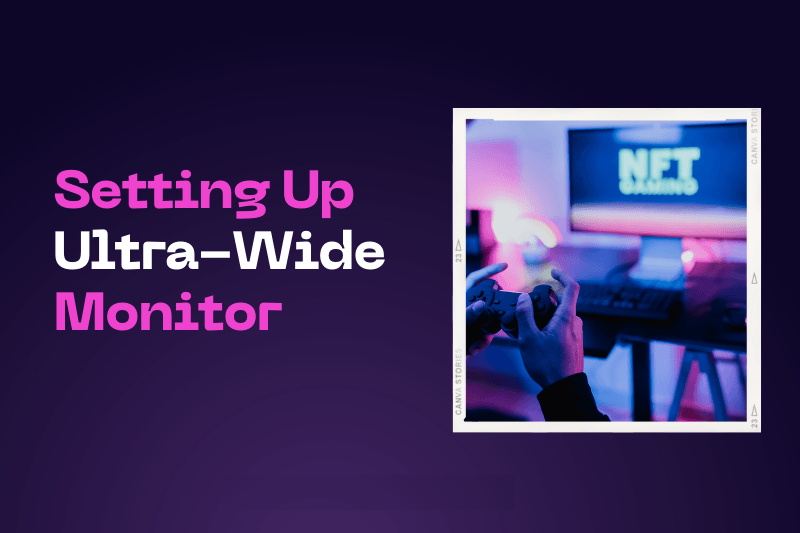Setting Up an Ultra-Wide Gaming Monitor: Tips and Tricks
Calling all gamers! If you’re looking to take your gaming experience up a notch, consider investing in an ultra-wide gaming monitor. With its larger screen and wider aspect ratio, it’s no wonder why more and more gamers are making the switch. But before you rush out to buy one, there are some important things you should know about setting up and using this type of monitor.
In this blog post, we’ll share with you some essential tips and tricks for getting the most out of your ultra-wide gaming monitor. From adjusting display settings to optimizing game graphics, we’ve got you covered!
What to Consider When Buying a Gaming Monitor
When you’re shopping for the best gaming monitor, there are a few factors to take into account. First, the size of your screen. Do you want a monitor that is wide or ultra-wide?
Second, what type of display technology do you prefer: IPS, VA, or TN?
Third, what resolution do you need? Fourth, what features are important to you? And finally, how much money are you willing to spend?
When it comes to gaming monitors and their viewing angles, most gamers will want either an ultrawide monitor or a 4K monitor.
Ultrawides don’t have as much vertical viewing space as 4K monitors but they offer more horizontal real estate which can be helpful if you want to game in multiple sitting positions.
A great ultrawide option is the Dell U2715H which has a 27-inch diagonal and offers a 2560 x 1440 resolution. It also has an IPS panel which means it has good color reproduction and viewing angles.
4K monitors are becoming increasingly popular because they offer such high resolutions for the price. They’re also great for multi-tasking as they can display several different items at once without sacrificing quality.
The best 4K monitor currently on the market is the Acer Predator XB271HU which offers a resolution of 3440 x 1440. It also has an HDR capable panel which means it can show brighter colors and darker details in shadow areas thanks to its wider color gamut.
Other features you might want to consider when buying a gaming monitor are response time, input lag, and panel type. Response time is important if you want to play games with quick responses.
Some monitors have low response times of 1ms or less, while others have higher response times of 6ms or more. Input lag is the delay between when you press a button and when the action actually appears onscreen.
Some monitors have very low input lag, while others have significantly higher input lag. Panel type is also important as it can affect how the image looks on the screen. Some panels are better for displaying dark and vibrant colors, while others are better for displaying accurate colors and details.
When shopping for a gaming monitor, keep in mind the factors listed above as well as your budget and preferences.
Ultra-Wide Monitors: Features and Specifications

Ultra-wide monitors are growing in popularity, and with good reason. They provide an immersive experience that can put you right into the game.
Some of the key features of ultra-wide monitors include:
Size: Ultra-wide monitors come in all shapes and sizes, so they’re perfect for any gaming setup.
Ultra-wide monitors come in all shapes and sizes, so they’re perfect for any gaming setup. Refresh Rate: Most ultra-wide monitors offer a refresh rate of 144Hz or above, giving you the smoothest gameplay possible.
Most ultra-wide monitors offer a refresh rate of 144Hz or above, giving you the smoothest gameplay possible. Resolution: Many ultra-wide monitors have insane resolution options (up to 4K), letting you see every detail onscreen.
Many ultra-wide monitors have insane resolution options (up to 4K), letting you see every detail onscreen. Viewing Angles: Like all curved displays, ultra-wide Monitors have varying viewing angles which can be adjusted depending on your needs.
Different Types of Gaming Monitors
No matter what type of gamer you are, you will need a gaming monitor. There are different types of monitors for different types of gamers, so it is important to know what type you need before making your purchase.
The first thing to consider when shopping for a gaming monitor is the size and resolution of thescreen. For most people, a 27-inch monitor with a resolution of 1920×1080 is more than enough for basic gaming. If you want to get into professional or eSports games, however, you’ll need to invest in a larger monitor with better specs.
A 34-inch ultra-wide monitor with 2560×1440 resolution is perfect for most people who want to game at home or on the go. These monitors offer much more screen real estate than traditional 16:9 monitors, so they are great for multitasking and working on multiple documents at the same time.
If you want the best graphics possible, however, you’ll need to invest in a 40-inch or greater screen with 3840×2160 resolution. These monitors offer four times as many pixels as 1920×1080 screens and provide stunning images that rivals those seen in high-end games consoles like the Xbox One and PlayStation 4.
How to Assemble Your Monitor
When you’re shopping for a monitor, there are a few things to keep in mind. First, what type of gaming do you plan to use it for? Second, how many monitors will be used simultaneously? Third, what size desk do you have? Fourth, what kind of materials will your monitor be placed on (steel or plastic)? Finally, how much money do you want to spend?
There are four main types of gaming monitors: standard (4:3), ultrawide (21:9), ultrawide (3440×1440), and wide-gamut (100% NTSC or sRGB). Each has its own set of benefits and disadvantages. Before making your purchase, consider which type of gaming is most important to you and what features are most important to you.
Ultrawides offer the widest viewing angles and the most immersive experience, but they can be challenging to use because they require more space than standard or wide-gamut monitors. Wide-gamut monitors cover a wider range of colors than typical monitors, so they are well suited for photo and video editing or other applications that require high color accuracy.
Standard monitors are the most common type and offer an adequate experience for most gamers. They can be used with either games or applications that don’t need accurate colors.
Setting Up the Monitor
There’s no need to be a technical wizard to get the most out of your gaming monitor. In this guide, we’ll outline the steps you need to take to set up your new ultra-wide gaming monitor and get ready for smooth gameplay.
First, Identify Your Monitor Type
There are 3 main types of monitors: desktops with a built-in display, laptop screens, and standalone displays like the Ultra-Wide Gaming Monitor.
Tablets also come in various form factors and use different monitors so consult your specific device’s manual or tech support website for help identifying your particular monitor type.
Once you know what type of monitor you have, find an adapter that will work with it. Most monitors use either a VGA or HDMI connection but some (like the Omen X27) use DisplayPort which is more exclusive for high-end graphics cards. Make sure to purchase the correct adapter according to your monitor type.
Next, Connect Your Monitor to Your Computer
Connecting your monitor is easy—just plug in the power cord and connect either the VGA or HDMI cable from your adapter to your computer’s video output. The same goes for DisplayPort cables; just make sure yours has the correct connector for your monitor if it uses that connection.
If you have an ultrathin laptop such as the Razer Blade Stealth or an even newer model thin laptop like Dell Inspirion 14 7000 with an ultrawide panel, you’ll also need to configure your laptop’s settings in order to use the monitor. Each laptop is different so consult your manual or contact your support team for help.
Games and Apps on Your Monitor
Once you have your monitor connected and configured, it’s time to enjoy some gaming goodness. First, make sure games and apps are optimized for a ultra-wide display by opening the Properties menu of the app or game and adjusting the resolution (if necessary).
Most games will automatically detect if you have a wider display and offer an optional mode or setting that will provide a more comfortable experience. If not, you can manually force-enable the wider display mode in most cases by turning on “Anchor Mode” in the settings.
And that’s all there is to it! You’re now ready to get lost in worlds of gaming with a magnificent ultra-wide monitor that fills your screen like never before!
Testing the Monitor:
In order to make sure your new monitor is properly set-up, it’s important to test it out before putting any hard work into configuring the settings. Here are some simple tests to perform:
- Look for the optimum setting for your monitor. Most monitors have a “Standard” or “Custom” adjustment mode which will give you a better idea of how each individual pixel is displaying image quality. If the image appears too bright or too dark, adjust the brightness and contrast accordingly.
- Try different viewing angles in order to determine if there is any distortion in the picture when viewed from an extreme angle. Check if text or objects look blurry when viewed at an angle; if so, adjust the monitor’s tilt/angle settings until they are straightened out.
- To test color accuracy, open up a photo program and try adjusting the color temperature (e.g., Coolors). Remember that too high of a color temperature can make images look cool or artificially bleach-out colors; likewise, lowering the temperature can make things look too warm or desaturated against colored backgrounds.
Conclusion
Setting up an ultra-wide gaming monitor can be a daunting task if you’re not familiar with the process. In this article, we provide tips and tricks to make the setup as easy as possible for you.
We also answer some common questions that might come up during the process, so that you can rest assured that your new wide-screen experience will be perfect. Thanks for reading and let us know in the comments which type of gaming monitor you are looking to set up!







